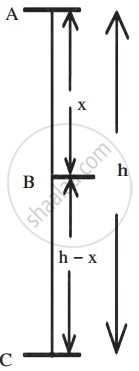
Free Fall
1. At Point A (Height = h)
The object is stationary, so:
K.E. = `"1"/"2"` mass x velocity2
K.E. = `"1"/"2"`mν2
K.E. = 0 (since velocity v = 0).
P.E. = mgh (the energy due to its height above the ground).
Total energy:
T.E. = K.E. + P.E.
T.E. = 0 + mgh
T.E. = mgh
2. At Point B (Height = h−x)
The object has fallen a distance xxx and is now at height h−x. It gains velocity due to gravity.The velocity at B: v2B=2gx
K.E. at B = `"1"/"2"`mvB2=`"1"/"2"`m(2gx)
K.E. = mgx (energy due to motion).
P.E. at B = mg (h-x) (energy due to remaining height).
P.E. = mgh - mgx
Total Energy:
T.E. = K.E. + P.E.
T.E. = mgx + mgh - mgx
T.E. = mgh
3. At Point C (Ground Level, Height = 0)
The object reaches the ground, so:
u = 0, s = h, a = g
v2 = u2 + 2as
v2C = 0 + 2gh
K.E. = `"1"/"2"` mvC2=`"1"/"2"`m(2gh)
K.E. = mgh (all energy is converted to motion).
The height of the object from the ground at point C is
h = 0
P.E. = mgh = 0 (no height above ground).
Total Energy:
T.E. = K.E. + P.E.
T.E. = mgh + 0
T.E. = mgh
Conclusion: From the calculations at points A, B, and C. The total energy remains constant throughout the fall.
T.E. = K.E. + P.E. = mgh
As the object falls
- Potential energy decreases as height decreases.
- Kinetic energy increases as velocity increases.
At any point during the fall, the total energy (T.E.) is the sum of P.E. and K.E., and it always equals mgh. This demonstrates the Law of Conservation of Energy, where energy is neither created nor destroyed, only converted between forms.

